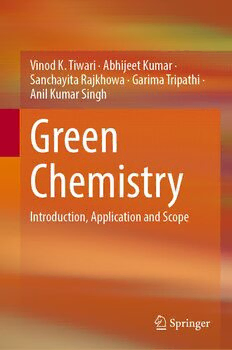
Green Chemistry: Introduction, Application and Scope PDF
Preview Green Chemistry: Introduction, Application and Scope
Vinod K. Tiwari · Abhijeet Kumar · Sanchayita Rajkhowa · Garima Tripathi · Anil Kumar Singh Green Chemistry Introduction, Application and Scope Green Chemistry · · Vinod K. Tiwari Abhijeet Kumar · · Sanchayita Rajkhowa Garima Tripathi Anil Kumar Singh Green Chemistry Introduction, Application and Scope VinodK.Tiwari AbhijeetKumar DepartmentofChemistry DepartmentofChemistry BanarasHinduUniversity MahatmaGandhiCentralUniversity Varanasi,UttarPradesh,India Motihari,Bihar,India SanchayitaRajkhowa GarimaTripathi DepartmentofChemistry DepartmentofChemistry TheAssamRoyalGlobalUniversity T.N.B.College Guwahati,Assam,India Bhagalpur,Bihar,India AnilKumarSingh DepartmentofChemistry MahatmaGandhiCentralUniversity Motihari,Bihar,India ISBN 978-981-19-2733-1 ISBN 978-981-19-2734-8 (eBook) https://doi.org/10.1007/978-981-19-2734-8 ©TheEditor(s)(ifapplicable)andTheAuthor(s),underexclusivelicensetoSpringerNature SingaporePteLtd.2022 Thisworkissubjecttocopyright.AllrightsaresolelyandexclusivelylicensedbythePublisher,whether thewholeorpartofthematerialisconcerned,specificallytherightsoftranslation,reprinting,reuse ofillustrations,recitation,broadcasting,reproductiononmicrofilmsorinanyotherphysicalway,and transmissionorinformationstorageandretrieval,electronicadaptation,computersoftware,orbysimilar ordissimilarmethodologynowknownorhereafterdeveloped. Theuseofgeneraldescriptivenames,registerednames,trademarks,servicemarks,etc.inthispublication doesnotimply,evenintheabsenceofaspecificstatement,thatsuchnamesareexemptfromtherelevant protectivelawsandregulationsandthereforefreeforgeneraluse. Thepublisher,theauthors,andtheeditorsaresafetoassumethattheadviceandinformationinthisbook arebelievedtobetrueandaccurateatthedateofpublication.Neitherthepublishernortheauthorsor theeditorsgiveawarranty,expressedorimplied,withrespecttothematerialcontainedhereinorforany errorsoromissionsthatmayhavebeenmade.Thepublisherremainsneutralwithregardtojurisdictional claimsinpublishedmapsandinstitutionalaffiliations. ThisSpringerimprintispublishedbytheregisteredcompanySpringerNatureSingaporePteLtd. The registered company address is: 152 Beach Road, #21-01/04 Gateway East, Singapore 189721, Singapore Foreword The design of chemical reaction that reduces or eliminates the generation of hazardous substances demands theadoption ofinnovative andrevolutionary green chemistry approach. The practice of green chemistry methodology in organic synthesis has certainly led to significant environmental benefits and has strength- enedeconomicinnovations.ThisbookonGreenChemistry—Introduction,Applica- tion,andScopeprovidesaveryinterestingoverviewofthefundamentalprinciples of green chemistry with their notable perspectives. This book would be useful to UG/PGstudents,academicians,researchersaswellaschemistsworkinginchemical industriesbecauseoftheabsenceofanyworthwhilebookonthissubject. ThisbookbyVinodK.Tiwariandcoworkersbeginswiththeintroductionofgreen chemistry and its twelve principles coined by Paul Anastas and John Warner and movesforwardwiththeexhaustivediscussionontheimportantmetricsofthegreen chemistrysuchasE-factor,atomeconomy toevaluatethegreennessofachemical process.Otherimportantdiscussionsinthischapterincludeprinciplesofinherently saferdesign(ISD)andbarriersinthedirectionofimplementationofdifferentgreen chemistryprinciples. Various environmentally benign alternatives such as microwave, ultrasound, visible light, ball milling, mechanocatalysis, and electro-organic approaches to conventional C–C and C–X (X = heteroatom) bond-forming organic transforma- tions have been elaborated in Chap. 2. Following this, the chapter deals with the introductionofgreenersolvents,i.e.,water,ionicliquid,supercriticalCO ,switch- 2 ablesolvent,fluorousbiphasicsystem,polyethyleneglycolaswellasusingsolvents derivedfrombiobasedfeedstocksuchasvegetableoil.Thegrowingimpactofionic liquidsinsynthesismainlyinheterocyclicsynthesisandapplicationincarbohydrate chemistryiselaboratedinChaps.4and5,respectively. Abookongreenchemistrytodaywouldnothavebeenjustifiedifthisdoesnot includecatalyticreaction.Theauthorhasrightlyincludedtheapplicationofvarious catalytictransformationssuchasoxidation,reduction,carbon–carbon,andcarbon– heteroatombond-formingreactionsinthisbook.Emergingconceptoforganocatal- ysis, types of catalysts, and application in asymmetric synthesis is appropriately highlightedinChap.7. v vi Foreword Furthermore,thesignificantimportanceofenzyme-mediatedtransformationand notableapplicationsofgreenchemistryinsomereal-worldcases,e.g.,thesynthesis ofpharmaceuticals,API,polymers,etc.,havebeendiscussedinthelasttwochapters. Also,theimpactofemployinggreenmethodanditscomparisonwiththeconventional approachesarehighlightedinthisbook. All the chapters provide relevant references to original papers, reviews, and somespecializedbooksonthetopic.Thepresentbookongreenchemistrypresents all essential and important concepts with clarity and provides up-to-date informa- tion on almost all aspects of green chemistry for UG/PG and doctoral students of chemistry. It becomes apparent that this book has basic objective of bringing the subjectclarity,withoutcompromisingonmostessentialconcepts,butavoidingless- frequentlyencounteredcomponents.Thisbookshouldbesuccessfulindeveloping “fondness” for green chemistry among scientific community. This book should be usefultothechemistryacademicfacultyandindustrialchemistsequally.Itisamuch- welcomeadditiontorepertoireofpracticingresearchersandacademics.Academic andresearchbackgroundoftheauthorsjustifytheirbookonthegreenchemistry. Prof.GaneshPandey,FNA,FNASc,FASc DistinguishedProfessor DepartmentofChemistry InstituteofScience BanarasHinduUniversity Varanasi,India Preface In the present scenario, the development of a greener and environment-friendly approach to minimize and/or avoid the generation of waste material during the synthesisofavastrangeofcompoundswithdiverseapplicationshasbeenconsid- eredtobeanimportantareaofinvestigation.Especiallyafterrealizingtheshort-and long-termadverseeffectofconventionalsyntheticapproachesonsafety,health,and environment (SHE), the attention of research community took a paradigm shift in achievingthesynthesisfromconventionaltoefficientsyntheticmethodswithutmost careoflivesandenvironment,theessentialsofsustainabledevelopment.Therefore, wearepresentingthisbookwiththetitleGreenChemistry—Introduction,Applica- tion, and Scope for a better understanding of green chemistry fundamentals with notableperspectives,particularlyaboutthevariousemergingsyntheticapproaches under environmentally benign conditions that would prove to be an important and usefulpieceofstudymaterialtothereaders. This book has been divided into nine chapters that cover the topics mentioned inthegreenchemistrycourseofmostoftheacademicinstitutionsacrosstheworld. Thus,itwouldofferthestudentsofUG/PGaswellasresearchersfrombothacademic institutionsandindustryacompleteunderstandingofthedifferentemergingtopics using the latest notable examples. Chapter 1 titled “Green Chemistry: Introduc- tiontotheBasicPrinciples”providesthefundamentalinformationaboutthegreen chemistryanditstwelveprinciplesjointlycoinedbyPaulAnastasandJohnWarner. These principles act as a guiding tool for the development of an environmentally benign process. This chapter covers the exhaustive discussion about some of the importantmetricslikeE-factor,atomeconomy,etc.,toevaluatethegreennessofa chemical process. Further, different ways to prevent and minimize the generation of waste material in a chemical process have also been discussed with the help of suitable examples. Other important topics such as the principle ofinherently safer design(ISD)andbarriersinthedirectionofimplementationofdifferentgreenchem- istryprincipleshavealsobeencovered.InChap.2titled“Energy-EfficientProcess in Organic Synthesis,” various environmentally benign alternatives to the conven- tional heating methods adopted to achieve different types of organic transforma- tions, for example, C–C bond-forming reactions, heterocyclic synthesis, etc., have vii viii Preface beendiscussed.Wehavebrieflycoveredtheapplicationsofmicrowave,ultrasound, visiblelight,andelectro-organicmethodinachievingdifferenttypesoforganictrans- formations.Also,theapplicationofballmillingmethodwhichisalsoemergingas anenergy-efficientwayinorganicsynthesis,inparticular,forthedirectandindirect mechanocatalysis, has been highlighted with the latest examples. In Chap. 3 titled “GreenSolvents:ApplicationinOrganicSynthesis,”discussionisabouttheappli- cationofdifferenttypesofgreeneralternativestoconventionalorganicsolventsin organicsynthesishavebeenincluded.Organicreactionsexploredusingwater,ionic liquid,supercriticalCO ,switchablesolvent,fluorousbiphasicsystem,polyethylene 2 glycolaswellasusingsolventsderivedfrombiobasedfeedstocksuchasvegetableoil havebeendiscussedelaborately.InChap.4titled“GrowingImpactofIonicLiquids inHeterocyclicChemistry,”theimportanceofionicliquidsasanothergreeneralter- nativetoconventionalsolventsandtheirapplicationasasolventinorganicsynthesis particularly for the synthesis of heterocyclic rings have been covered thoroughly. Chapter 5 titled “Growing Impact of Ionic Liquids in Carbohydrate Chemistry,” highlightstheapplicationsofionicliquidsincarbohydratechemistryingreatdetail. Chapter6titled“Catalysis:ApplicationandScopeinOrganicSynthesis”coversthe vastdiscussionondifferenttypesofcatalysisandtheirapplicationsinvarioustypesof organictransformationsincludingoxidation,reduction,carbon–carbon,andcarbon– heteroatombondformations.Organocatalysisisnowemergedasavaluableareaof researchandbeyonddoubtatrulygreeneralternativetothetransitionmetal-based catalysis.Consideringitsimmenseimportanceinasymmetricorganicsynthesis,this year’sNobelPrizeinChemistryhasbeenawardedtoProf.BenjaminListandProf. David W. C. MacMillan, and thus, a separate Chap. 7 titled “Organocatalysis: A VersatileToolforAsymmetricGreenOrganicSyntheses”hasbeenpresented.This chapter is dedicated to organocatalysis with brief discussions related to different types of organocatalysis and their applications in various asymmetric transforma- tions. Furthermore, the significant importance of enzyme-mediated transformation is considered and included in Chap. 8 titled “Enzymes in Organic Synthesis.” At the last, Chap. 9 titled “Application of Green Chemistry: Examples of Real-World Cases”focusesonthenotableapplicationofenvironmentallybenignapproachesin somereal-worldcasessuchasforthesynthesisofpharmaceuticals,APIs,polymers, etc.Inaddition,theimpactofemployinggreenmethodandtheircomparisonwith the conventional approaches have also been highlighted in this book. Overall, this bookpresentedadetailedscopeofgreenchemistrytoawiderangeofreadersand investigators. Wewouldliketoexpressourheartfeltthanksanddeepsenseofappreciationto Prof.GaneshPandey,DistinguishedProfessorattheDepartmentofChemistry,Insti- tuteofScience,BanarasHinduUniversity,forhisconsistentsupportandmoreoverfor writingtheveneratedforewordtotheSpringerbook.TheauthorsthankProf.Richard R.Schmidt(UniversitatKonstanz),Prof.XiChen(UniversityofCalifornia-Davis), Prof.R.P.Tripathi(CSIR-CentralDrugResearchInstitute,Lucknow),Prof.Pradeep K. Tripathi (CSIR-National Chemical Laboratory, Pune), and Prof. D. Basavaiah (University of Hyderabad) for their useful suggestions during the writing of this book.WealsothankbothDr.AnandK.Agrahari(UC-DavisandMr.MangalSingh Preface ix Yadav(BHU,Varanasi)fortheirgreatcaretothereferencesection.Theauthorsare highlythankfultothe“SpringerNature”whoimplicittheimportanceofthepresent bookandconsideredthepublishingwithgreatinterest.Lastbutnotleast,weexpress our special thanks to the entire editorial team associated with Springer Nature, in particularMs.PriyaVyas,AssociateEditor—AppliedSciencesandEngineering,Ms. SharmilaMaryPannerSelvam,ProjectCoordinator,andMr.MadanagopalDeena- dayalan,ProjectManager,whoextendedtheirsupportinpublishingthisthemewith the high standard of publication maintained in bringing out this book on Green Chemistry—Introduction,Application,andScopewithSpringerNature. Varanasi,India VinodK.Tiwari Motihari,India AbhijeetKumar Guwahati,India SanchayitaRajkhowa Bhagalpur,India GarimaTripathi Motihari,India AnilKumarSingh Contents 1 GreenChemistry:IntroductiontotheBasicPrinciples ............. 1 1 Introduction ................................................. 1 2 PrinciplesofGreenChemistry ................................. 1 3 PrincipleofInherentlySaferDesign(ISD) ....................... 30 4 VariousBarriersintheImplementationofGreenChemistry ........ 31 References ..................................................... 34 2 Energy-EfficientProcessinOrganicSynthesis .................... 37 1 Introduction ................................................. 37 2 Microwave-AssistedOrganicSynthesis .......................... 38 2.1 Microwave-AssistedCouplingReactions ................... 39 2.2 Microwave-AssistedHeterocyclicSynthesis ................. 41 3 BallMillingMethodforOrganicSynthesis ...................... 48 3.1 Application of Ball Mill Method in Synthesis ofHeterocycles ......................................... 49 3.2 AsymmetricSynthesisUnderBallMillMethodUsing Organocatalysts ......................................... 51 3.3 CouplingReactionUnderBallMillCondition ............... 53 4 UltrasonicMethodsinOrganicSynthesis ........................ 55 5 Photo-InducedOrganicTransformations ......................... 58 5.1 Photo-CatalystCatalyzedC–CandC–XBondForming Reaction ............................................... 59 5.2 Photo-InducedPeptideCouplingReaction .................. 64 5.3 Photo-InducedDecarboxylativeCoupling ................... 65 6 ElectrochemicalApproachforOrganicSynthesis ................. 69 7 Conclusions ................................................. 72 References ..................................................... 72 3 GreenSolvents:ApplicationinOrganicSynthesis ................. 79 1 Introduction ................................................. 79 2 TypesofGreenSolvents ...................................... 80 3 SolventSelectionGuides ...................................... 80 xi
